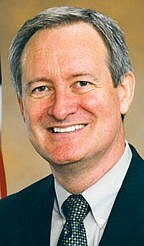An Idaho-style alternative to Biden's 30 by 30 initiative
SEN. MIKE CRAPO and SEN. JIM RISCH | Bonners Ferry Herald | UPDATED 3 years, 3 months AGO
As Idahoans, we have a stronger incentive than anyone to preserve, maintain and enhance the land we call home — like reducing wildfire threats, improving soil health, restoring waterways and enhancing wildlife habitat.
A far more productive path than President Biden’s vague call to put 30 percent of our land and water in conservation status by 2030 (known as the 30 by 30 initiative) is to focus on improving the health of our existing public lands and waters. We recently joined congressional colleagues representing Western states in advancing the Senate and Congressional Western Caucuses’ outcome-based conservation proposal, titled “Western Conservation Principles,” stressing this approach.
In January, President Biden signed an executive order, which included “the goal of conserving at least 30 percent of our lands and waters by 2030.” The ambiguity of what constitutes conservation status or through what process land management decisions will be made has understandably worried many Idahoans and others with agriculture and natural resource-based economies. We expressed concern with this lack of clarity in our proposal, emphasizing, “the ambiguous ‘conservation status’ has yet to be defined, and even if it were to be defined, it is clear the Administration does not know what percentage of lands and waters are currently meeting this status.”
For example, this uncertainty has led to discussions about whether public lands leased for livestock grazing should be counted toward the President’s 30 percent goal, despite grazing being a critical component of federal land management and conservation efforts. It is similarly unclear how private agricultural land will be treated, despite hosts of farmers and ranchers participating in voluntary conservation efforts. This lack of clarity reinforces the need to step back and focus on successfully managing lands already in the public trust rather than nebulous and polarizing percentages.
The Farm Bill remains one of our greatest tools to address environmental issues, because it authorizes conservation programs providing incentive-based tools for landowners to implement conservation practices that improve air and water quality, enhance and protect wildlife habitat, and restore our soil. Farm Bill conservation programs provide assistance for conservation on private lands resulting in public benefits. Additionally, these programs broaden collaborative work between federal agencies and local stakeholders to advance environmental and collaborative sustainability. We need to focus on furthering this kind of incentive-based, locally-driven conservation progress
We should not be focusing on unclear goals that create confusion and do not lead to greater conservation outcomes. The “Western Conservation Principles” urge the Biden Administration to focus efforts on issues plaguing our public lands, including:
- Forest health;
- Invasive species;
- Wild horses and burros;
- Superfund Sites;
- Park visitation;
- Abandoned mine and orphan well reclamation;
- Checkerboard and landlocked management;
- Biodiversity and species recovery; and
- Promoting and protecting water infrastructure.
We stressed, “We must maximize the conservation benefits provided by activities like grazing, hunting, logging, and mineral development. We also must leverage the expertise of our local partners including through the use of existing shared stewardship authorities and seek policies that further enhance these tools.” We called for a collaborative approach that includes:
- Full use of our tools;
- Shared stewardship:
- Public-private partnerships;
- Reporting and monitoring;
- Streamlined processes;
- Litigation reform; and
- Audit of existing programs.
Those who live and work on the land are most invested in conserving it. The best way to ensure we continue to have healthy and resilient landscapes is by working cooperatively with property owners to promote conservation. Conservation can work in tandem with—not in opposition to—our agricultural and natural resources industries. The “Western Conservation Principles” provide a commonsense outline of how we can conserve our natural environment and our Idaho way of life.



